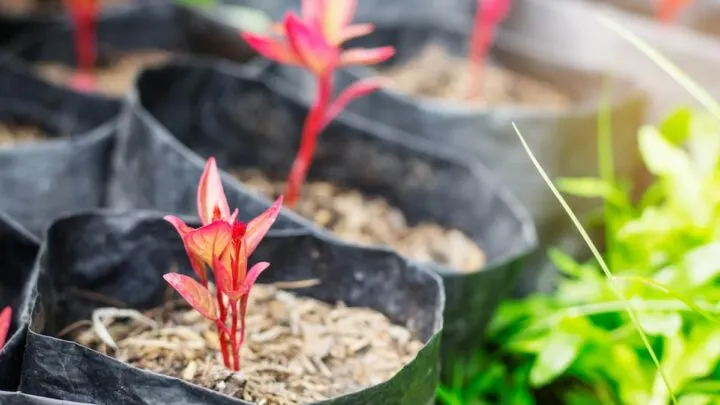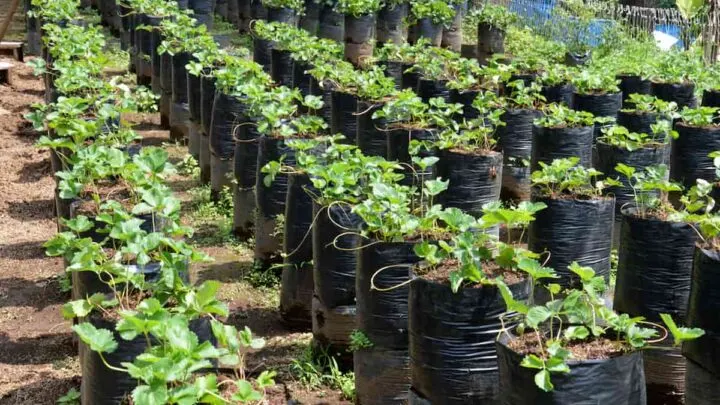As you probably know, there are so many different ways to garden and different containers to grow your plants in. The more popular ways to grow involve raised beds or your everyday plastic or ceramic pot. Then there is just planting everything directly in the ground! Grow bags are just another different container to grow your plants in. They are simply bags, usually plastic, though they do come in different fabrics, and you fill them with dirt and plant your items in them. They do come in different sizes (1 gallon, 5 gallons, etc.)
There are many things to think about when you are deciding what to plant your plants in. When planting your garden, these are things to think about, from root development to versatility and how convenient it is. Like all things, grow bags have many pros and cons to using them in your garden.
In today’s article, we are going to be discussing all things grow bags! All the pros of using grow bags and the cons you may run into while using them as well.

Pros of Using Grow Bags
First, we will get into the pros of using grow bags. Are they worth it, how well do things grow in them, and more!
| Grow Bag Pros | |
| Better Soil drainage | Grow bags allow water to break through their walls and escape through the bottom of the bag. Overwatering is very hard to do in a grow bag. |
| Lighter | Since grow bags are usually thin plastic or light fabric, you don’t get that extra heavy hard plastic or ceramic weight you would with other pots. You pretty much just have the weight from the soil and the plant itself, which can help in shifting or moving the bag if need be. |
| Promotes Healthy Root Development | When roots hit the wall in a regular hard pot, they begin to grow in a circle. The roots can grow so much in this circle that they get “rootbound” where their roots are all entangled and this can cause lasting effects on how the plant grows. When roots in a grow bag hit the wall, they come in contact with the air (because grow bags are breathable) then something happens called “air-pruning. Air pruning allows the plant to stop growing that root that hits the edge, and start growing new roots. |
| Breathable | Grow fabric bags are made with breathable fabric, that allows air to come through. This also helps drain the soil and disperse heat. |
| Space Savers | Usually the bags are small and easy to stick wherever you have the space. They can easily be placed in tight spaces, or anywhere in your yard or deck. You can also easily store grow bags since they come flattened out in bag, you can save them on any shelf for later. |

Cons of Using Grow Bags
Now let’s talk about the cons of using grow bags. Why they aren’t as popular as other methods of growing plants, and why that is.
| Grow Bag Cons | |
| Expensive | Grow bags aren’t the most cost effective means of growing plants. One 5-7 gallon grow bag will generally cost you around $10-15. The fabric grow bags are a bit cheaper at around $3-5 for a 3 gallon bag. Hard plastic containers run much cheaper and are easier to find. |
| Don’t Last As Long | Both the plastic and fabric grow bags don’t have very long life spans. The fabric bags may hold up for a few years at most, but they usually start to deteriorate and mold (see below). Plastic bags may last longer, but the plastic is thin and gets ripped easily. |
| Fast Drying | Tying into the pro of being breathable, this is also a con. Because they are so breathable, the soil dries out very quickly and you must water much more frequently than you normally would. In a hard plastic container or a raised bed you may water every other day, but in a grow bag you would certainly have to water once a day. If you live somewhere very hot and dry, these may not be the best solution for you. |
| Unattractive | When it comes down to it, these grow bags really aren’t that “pretty”. Especially the plastic bags can be a bit of an eye sore when looking upon a nice garden. Compared to a well done raised bed or a lovely hand crafted ceramic pot, grow bags aren’t the winners. |
| Bad for the Environment | Most bags you find on the market are plastic or just regular fabric bags and both of these are not environmentally friendly. After you are done using them, you would have to throw them in the trash, where as you can get nicer containers that actually can be composted. |
| Hard to Move | Although they may be lighter, it is a pain to try and move these bags. Normally they don’t have handles and still it very heavy to try and lift a pot of soil. |

My Personal Opinion on Grow Bags
Personally, I am not the largest fan of plastic grow bags. I find that I can only have them last one season before they get ripped or shredded, and I don’t like wasting all that extra plastic (or money). Fabric bags, on the other hand, are a bit better.
They are great for transplants since they promote such wonderful root growth. I usually start my seeds in a seed tray, move them to a 3-gallon fabric bag, and once they are ready, I transplant the plants into their final destination. The bigger fabric pots are good to use as well if they are in a nice area where they don’t have to be moved. Overall, fabric bags are a great way to grow any kind of plant.
What Grows Best in Grow Bags?
Grow bags are great for plants with shallow roots and not a very complex root system. Some vegetables that will thrive in grow bags include:
- Tomatoes
- Peppers
- Herbs (basil, sage, etc.)
- Lettuce
- Potatoes
- Onions
Flowers also will do wonderfully in grow bags. Not many fruits can be planted in grow bags; however, strawberries, blackberries, and raspberries can be planted in larger grow bags.
Grow Bag Alternatives
If you have read through and are may leaning towards no grow bags, don’t fret! There are a ton of other ways to plant your plants. You can build a raised bed out of simple 4×4 wood. You can go the hard plastic or ceramic pot route. You can use other things like old tires and wagons, build a rock garden, or even use an old toilet as your planters.
If you are still curious about the, grow bag situation, but things like the environmental waste weigh on you, there is an option for that as well. They do make grow bags that are compostable. They do everything a grow bag does, but they only will last one season, and once that season is over, you can toss the entire plant, soil, and pot into your compost.
Final Thoughts
Although grow bags have their disadvantages, they are still a great way to plant your garden. The fact alone that they promote healthy root systems and help the plant’s air prune is a really helpful advantage to growing plants. Rootbound plants are a pain to manage, and your yield may be affected in the long run, but not when the roots can live freely and grow happily! Happy gardening!

Hi there, my name is Allie and welcome to my blog; GareningWithAllie!
Much of what you see written here is just our personal experiences with gardening. Along with the content I write here, there is also a unique collection of gardening topics covered by some of our close friends. I hope you find everything you read here to be helpful, informative, and something that can make your gardening journey the most lovely experience ever! With that said, Happy Gardening!
